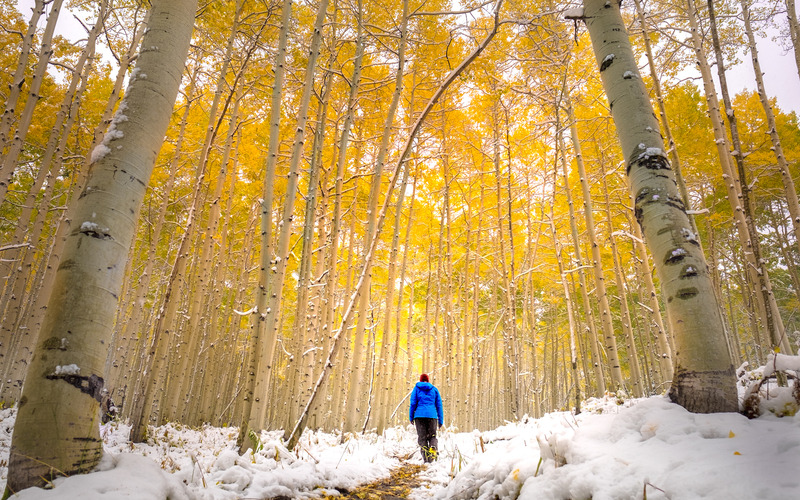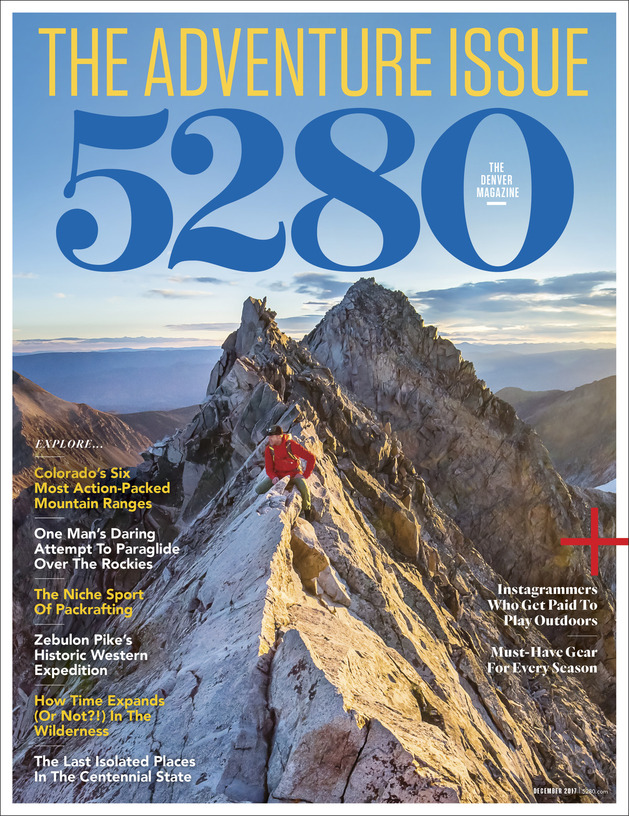The Local newsletter is your free, daily guide to life in Colorado. For locals, by locals.
From the outset, I show little promise as a professional adventurer. At a few minutes past 5 on an August morning (I was supposed to be there at 5 sharp), I report to Vail Village to meet my boss for the day, Ken Hoeve. He asks if I brought a helmet. I had not. An extra layer? Nope. Gloves? Sorry. Water? Um….
Wearing Hoeve’s wife’s gloves and the jacket literally off his back, I climb onto one of the QuietKat electric mountain bikes Hoeve has procured for our ride to the summit of Vail Mountain, where we plan to watch the sunrise. With our pedaling aided by 750-watt motors, we’re soon halfway up the hill, the village aglow below and the stars blazing above. Hoeve warns me that in the stillness of the early morning, we might startle sleeping bears.
Hoeve, 46, has lived in Eagle County for 27 years, 16 of them as a slopeside weatherman for Vail TV8’s morning show. He got first tracks, a few bucks an hour, and a little bit of fame for his snow condition reports. But in recent years, he’s garnered even more recognition because of his Instagram account—a constant stream of fly-fishing, kayaking, and ski porn photos that makes city slickers, like me, question their life choices.
That’s because Hoeve decided to eschew the cruel world of cubicles to join the growing ranks of “professional adventurers.” These are folks who have neither traditional celebrity nor trust funds yet still seem to spend most of their time traipsing through the great outdoors, courting exhilaration and natural beauty. The key to their freedom is almost subliminal, discreetly imbued in the message: Brands have taken to paying everyday people with extraordinary social media personas to include their products in posts. But, Hoeve says, you have to make a concerted effort to get off the couch and into the wild.
“Companies aren’t going to give you gear if you don’t use it and post about it,” he says. Which is why it’s so important for us to beat the sun to the top of this mountain. Hoeve’s Instagram photos are stunning, but they’re not entirely unique. If you’re an outdoorsy Coloradan—or aspire to be one—pro adventurers’ trophy shots probably litter your social media feeds. So how are your seemingly normal neighbors able to cobble together such adrenaline-charged existences?
Hoeve’s landing in this spot was purely accidental: In 2014, he uploaded a photo of himself fishing from atop his Yeti cooler. Within a couple of hours, a Yeti rep asked him to become the company’s first “adventure ambassador.” Today, he touts Yeti’s coolers—as well as Kokatat’s fishing gear, Cova’s outdoor clothing, and NSP’s paddleboards, along with other brands—to the nearly 7,000 individuals who follow @kenhoeve on Instagram.
Considering our state’s abundant and diverse opportunities for playing outside, it shouldn’t be surprising that many Coloradans have turned Insta-pro. Marisa Jarae, a Floridian, moved to Denver to be closer to the mountains, and a subsequent hike to the summit of 14,067-foot Missouri Mountain inspired her to embrace outdoor photography. Today, 30,000 Instagram admirers watch @marisajarae bound up craggy peaks and stare wistfully at fairy-tale landscapes while outfitted in threads from Stio.
Kathleen Morton, 31, worked in marketing in Chicago before packing up her Toyota Camry and driving to Denver. Six years later, 96,000 Instagrammers monitor @tinyhousetinyfootprint’s travels across the West featuring Morton’s new home, a 1987 Toyota van. That’s 92,500 more followers than Governor John Hickenlooper has—which might explain why Zuke’s, a Durango-based dog treat and supplement company, pays Morton (and not the governor) to post pictures of her mutt, Peaches, lusting after its morsels.
These endorsement deals—the outdoor industry typically calls them “brand ambassadorships”—serve both parties. Adventurers get free gear and, occasionally, cash. Without the sponsorships, Hoeve says he wouldn’t even post on social media. “I wouldn’t give a shit if people saw me or not,” Hoeve says. “It’s a means to an end—and that end is adventure.” From these pros, companies receive something even the most recognizable stars, from Michael Jordan to Lady Gaga, can’t provide: authenticity.
Advertisers have sought to exploit authenticity for decades. But in 2000, Malcolm Gladwell gave voice to the power of grassroots influencers in his book The Tipping Point. Gladwell attributed the rise of trends such as Hush Puppies shoes in the 1990s to the clout exhibited by “people with a particular and rare set of social gifts.” Translation: the cool kids. Then came the internet, which granted talented, charismatic people the chance to reach a wider audience through blogs, YouTube, and Facebook. Those mediums also quantified advertisers’ potential market: By working with Italian fashion influencer Chiara Ferrangi, for instance, companies like Prada know they will have turnkey access to her 10.4 million Instagram followers.
As online influencers’ followings skyrocketed, so did their price tags. “Marketing departments couldn’t adjust quickly enough to pay them their rising demands,” says John Robbins, social media manager for Foghorn Labs, a Portland, Oregon, online marketing consultancy that counts Colorado brand Flylow Gear among its clients. So a few years ago, he says, brands started scattering ad dollars among a less famous but cheaper and more geographically diverse set of influencers, like Hoeve, Jarae, and Morton. When smaller companies, like Zuke’s, saw that fewer dollars still yielded increased awareness, they pounced.
Founded in 1995, Zuke’s grew so promising that Nestlé Purina Pet Care acquired the brand in 2014. Still, the dog treats and supplement company wanted a larger bite of the bone, so to speak. “The people who know us are diehard,” says Paula Miller, marketing brand manager for Zuke’s. But overall, Miller says, not a lot of people are aware of the brand. Facebook, blogs, Pinterest—nothing seemed to catch the eyes of their quarry, active dog owners.
In 2016, an outside PR rep recommended that Zuke’s launch a brand ambassador program. She argued consumers would connect with real people feeding their real dogs Zuke’s treats while, say, stand-up paddleboarding. The company vetted hundreds of Instagrammers, looking for people and pups who loved the outdoors together, and that July began with 22 ambassadors. Zuke’s Instagram following immediately exploded, from 4,000 to more than 30,000 as of October 2017. There are now 26 members of the #zukespack. “We want to focus on inspiration,” Miller says. “Everyone needs inspiration in their life, right?”
Perhaps. But authenticity remains the chief allure of ambassador programs: Eighty-three percent of consumers trust the opinions of people they believe they know, according to the Nielsen Global Trust in Advertising Survey. Neither online video ads nor ads on social networks nor banner ads crack 50 percent. And compared with the Laird Hamiltons of the adventure world, brand ambassadors are more relatable to your run-of-the-mill mortal, says Adam Lewis, the founder of Foghorn Labs. “It’s hard to relate to a superhuman athlete,” Lewis says.
Most ambassadors will work for a pair of socks, according to Lewis. Jarae, for instance, has established an apparel-for-posts deal with Stio, her biggest sponsor, based in Jackson, Wyoming. A small number of them make a lot more than sock money. Morton gets cash from Zuke’s, as does the entire #zukespack. Hoeve has a yearly contract with Yeti that guarantees him a small salary. Neither would disclose their specific fees. But one pro, who asked to remain anonymous, takes home between $30,000 and $50,000 a year.
Earning that much is rare, so most pro adventurers have day jobs. Jarae does marketing for the city of Longmont. Hoeve owns and occasionally drives for a limo service and guides kayakers on the Eagle River. Only Morton doesn’t hold a “regular” job—but that’s mainly because she lives in a van. Her expenses are minimal, just like her lifestyle.
Two roads diverge on Vail Mountain, and Hoeve, of course, picks the nearly vertical one. Almost immediately, I’m pouring sweat into Hoeve’s jacket, my breath disappears, and the bulging disc in my back begins to vigorously object to the strain. Before I can blame the thin air for my shameful lack of physical fitness, I realize my back tire’s gone flat, making my bike’s continued ascent impossible. Hoeve has been to this peak dozens of times. I’m expecting him to say something selfless like, Here, take my bike. No, no—don’t protest. This is your one chance to see the summit at sunrise. Go. GO!
Instead, Hoeve says, “Here’s what we’re going to do. I’m going to go to the top. You wait here.” As I watch the headlight on his bike disappear around a bend, Hoeve yells back, “I hope you’re not afraid of the dark!”
I’m not, but I am a little hurt—until I recall something Morton told me about pro adventuring: “Well, it is work. People don’t understand that.” Jarae, for instance, sleeps just three to four hours a night so she can spend weekday mornings in the mountains. Hoeve uses a GoPro to capture as many as 2,000 images per outing. They spend hours with editing software to perfect the photos and then write captions that inspire, engage, or astound, as the case demands. They are their own, tiny marketing agencies, and their adventure-hood depends on the quality and quantity of their campaigns. “I’m on a one-year contract with Yeti, which is smart of them,” Hoeve says. “What if I get hurt? Or my work suffers?” In other words, he says, he’s only as good as his last post.
Fortunately, Vail Mountain delivered some spectacular scenery that morning, Hoeve tells me after returning from the summit. The sunrise was gorgeous, framing the dark, ragged outline of the Gore Range to the east with alternating streaks of orange, pink, and blue. Hoeve even stumbled upon a pair of deer silently grazing. And I get to experience it all, despite my flat tire, because over the next couple of days, Hoeve posts the photos to Instagram: the bands of color, the majesty of the buck, and the toast he made to the coming day. The sunrise was only slightly obscured by Yeti’s sleek new coffee mug—which, according to an accompanying comment, will soon be available for purchase online.









